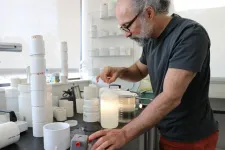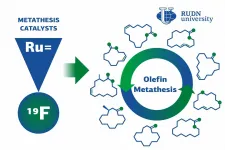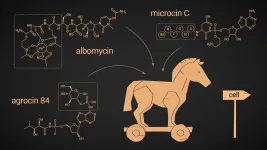(Press-News.org) A new study shows that when people replace their old couch with a new one that has no added flame retardants, levels of the harmful chemicals in household dust drop significantly. Replacing the foam inside the couch cushions is also just as effective. The findings confirm that choosing healthier furniture without flame retardants can make a big difference in people's--especially children's--everyday exposures to these toxic chemicals.
"We've long suspected that couches are a major source of toxic chemicals in dust. Now, for the first time, we have evidence demonstrating the positive impacts of replacing old furniture containing flame retardants," says lead author Kathryn Rodgers, a research scientist at Silent Spring Institute.
The findings appear in the journal Environment International.
Flame retardants can migrate out of furniture into air and dust, and end up in people's bodies. Exposure to the chemicals has been associated with cancer, thyroid disease, decreased fertility, lower IQ, and other harmful health effects. Infants and young children are particularly at risk since they crawl and play on the floor, where contaminated dust settles, and frequently put their hands in their mouths.
Until recently, the use of flame retardants in upholstered furniture across the United States and Canada was driven by a California flammability standard called TB117. Amid a public outcry over the toxicity of these chemicals and their lack of fire safety benefits, California updated TB117 to a new standard called TB117-2013. The new standard is designed to stop smoldering fires in the furniture's fabric before they reach the flammable foam inside, eliminating the need to add flame retardants to the foam. It went into effect in 2014 and allows manufacturers to make furniture without flame retardants.
A Healthy Exchange
To evaluate the impact of the new standard, Rodgers teamed up with researchers at the University of California, Davis; Environmental Working Group; the California Department of Toxic Substances Control; and Green Science Policy Institute. The researchers recruited participants from 33 homes in Northern California who were willing to swap out their old furniture for flame retardant-free options. About two-thirds of the participants replaced their entire upholstered couch. The rest replaced their couch's foam.
The team collected dust samples from each home before the swap out, and then several times afterward over a period of 18 months. Concentrations of flame retardants dropped significantly after the first six months, and most remained lower a year after the furniture was replaced. The same drops were also seen in homes that replaced just the foam.
Of the seven types of flame retardants the researchers tested for in dust, two in particular--PBDEs and TPHP--decreased the most. The drop in PBDE levels was not unexpected due to their widespread use in furniture that met the old standard, says Rodgers. The researchers also observed decreases in a group of flame retardants called chlorinated OPFRs. However, the declines were not as sustained over time likely because the chemicals are used in other products including textiles, plastics, adhesives, and rubber.
Up to Standard
"For decades, our population has been needlessly exposed to harmful flame retardants from their furniture as a result of an outdated flammability standard that provided no fire safety benefit," says co-author Arlene Blum, executive director of Green Science Policy Institute. "This study confirms that the new standard reduces exposure to toxic flame retardants in our homes. This is a win-win for public health and also fire safety."
Beginning June 25, under a new federal bill recently signed into law, all upholstered furniture imported or sold in the United States will have to comply with California's TB117-2013 flammability standard for upholstered furniture.
"With the new national flammability standard, manufacturers are now assured they can continue to make furniture that is fire-safe without the need for toxic flame retardants," says Andy Counts, CEO of American Home Furnishing Alliance. "This is good for our business, and even more important, for the health of our workers and the public."
Despite recent successes at removing flame retardants from furniture, the global market for flame retardants continues to grow as the chemicals are increasingly used in other types of consumer products. "The findings from the new study should spur state and federal policymakers to reduce other harmful and ineffective uses of flame retardants in other items such as television cases and building insulation," says Blum.
What Can Consumers Do?
Because furniture can last a long time, many homes still have furniture that meets the old standard and contains flame retardants. "Replacing old furniture can be costly and may not be an option for everyone," says Rodgers. "The good news is our study shows that replacing your couch's foam can be just as effective." People can replace the foam in their couch by contacting a local foam supplier and asking for new foam that does not contain added flame retardants.
It's also important to keep dust levels low, says Rodgers, since the chemicals like to hang out in dust. She recommends vacuuming using a strong vacuum with a motorized brush and HEPA filter and wiping surfaces with a wet cloth or mop. Fixing rips in the furniture's fabric to make sure the foam is not exposed and washing hands regularly are also important, she says.
For more tips on keeping harmful chemicals out of the home, download Silent Spring's Detox Me app.
INFORMATION:
Funding for this project was provided by Healthy Babies Bright Futures; JPB Foundation; U.S. Environmental Protection Agency (EPA-G2013-STAR-K1); UC Davis Superfund Research Center, National Institutes of Health, NIEHS award (P42-ES004699); UC Davis Environmental Health Center, NIEHS award (P30ES023513); and charitable donations to Silent Spring Institute.
Reference:
Rodgers, KM, D Bennett, R Moran, K Knox, T Stoiber, R Gill, TM Young, A Blum, RE Dodson. 2021. Do flame retardant concentrations change in dust after older upholstered furniture is replaced? Environment International. DOI: 10.1016/j.envint.2021.106513
About Silent Spring Institute:
Silent Spring Institute, located in Newton, Mass., is the leading scientific research organization dedicated to uncovering the link between chemicals in our everyday environments and women's health, with a focus on prevention. Founded in 1994, the institute is developing innovative tools to accelerate the transition to safer chemicals, while translating its science into policies that protect health. Visit us at http://www.silentspring.org and follow us on Twitter @SilentSpringIns.
What is the world made of? This question, which goes back millennia, was revisited by theoretical physicist Steven Weinberg from the University of Texas in Austin, TX, USA in the first of an international seminar series, 'All Things EFT'. Weinberg's seminar has now been published as an article in the journal EPJ H.
And Weinberg is well placed to discuss both Effective Field Theories (EFTs) and the nature of the Universe, as he shared the 1979 Nobel Prize for Physics for developing a theory to unify the weak and electromagnetic interactions between elementary particles. This fed into the development of the ...
Ruptures of the carotid artery (cervical artery dissection) are the most common cause of stroke in people under 50 years of age, with an annual incidence of 2-3 cases per 100,000 persons. Salicylic-acid preparations (acetylsalicylic acid: aspirin, Aspegic) and blood-thinning medication (anticoagulants) are used for treatment. The multicenter therapy study "Biomarkers and Antithrombotic Treatment in Cervical Artery Dissection (TREAT-CAD, NCT02046460)" investigated whether dissections - tears in the wall of vessels supplying blood to the brain - can be treated with aspirin or whether more complex blood thinning (anticoagulation) ...
Copepods are tiny crustaceans about the size of a grain of rice, but they are one of the most important parts of the Earth's aquatic ecosystems. Their behavior and interaction with the environment, however, remains a relative mystery. Now, a recent paper published in the Journal of Experimental Biology sheds new light on how these miniature marvels move and cluster in the ocean.
Researchers from Bigelow Laboratory of Ocean Sciences and the Georgia Institute of Technology found that the copepods gather around small vortexes in the ocean, a finding which could have significant implications for the food web.
"We're getting at a mechanism that helps us understand how the ecosystem ...
Chemists from RUDN University found out that fluorine and fluoroalkyl groups increase the efficiency of catalysts in metathesis reactions that are used in the pharmaceutical industry and polymer chemistry. The team also identified fluorine-containing compounds that can simplify the purification of the catalyst from the reaction product, making it reusable. The results of the study were published in the Russian Chemical Reviews journal.
Many medicinal drugs and polymers are based on olefins, organic compounds with a double bond between carbon atoms. To obtain useful substances from them, scientists used the metathesis reaction. In the course of metathesis, ...
New research from the University of Kent and Leeds Beckett University has found that feelings of shame and stigmatisation at the idea of contracting Covid-19 are linked to lower compliance of social distancing and the likelihood of reporting infection to authorities and potential contacts in Italy, South Korea and the USA.
In contrast, the study found that individuals who trust their Government's response to the Covid-19 pandemic and feel a mutual solidarity are more likely to report Covid-19 contraction to authorities and acquaintances.
In Italy and South Korea, individuals are also more likely to follow social distancing regulations if they trust their Government's response to the pandemic, while in the USA, trust does not lead to social distancing compliance. This could ...
The invisibility of dads who lose access to their children because of concerns about child neglect or their ability to provide safe care comes under the spotlight in new research.
A research partnership between the University of East Anglia and Lancaster University provides new evidence ('Up Against It': Understanding Fathers' Repeat Appearance in Local Authority Care Proceedings) about fathers' involvement in care and recurrent care proceedings in England.
A national conference today (Wednesday 24th March), co-hosted online by the two universities, will share key insights from this study, funded by the Nuffield ...
Skoltech researchers examined the antibiotic compounds that employ a 'Trojan horse' strategy to get into a bacterial cell unrecognized and prevent the synthesis of proteins, ultimately killing the cell. They were able to identify new gene clusters that look like those of known 'Trojan horses' - these likely guide the biosynthesis of new antimicrobials that require further investigation. The review paper was published in the journal RSC Chemical Biology.
When it comes to antimicrobial attacks, the most difficult thing is breaching the formidable outer defenses: getting inside a target cell to deploy the deadly weapon can be tricky. A number of antimicrobial compounds employ the well-known 'Trojan horse' strategy: they present themselves to a cell ...
During this unique study researchers from the University of Surrey and European Food Information Council (EUFIC) reviewed over 100 scientific papers to examine if different criteria exist in developing classification systems for processed foods and, if so, what distinguishes them.
Classification systems that categorise foods according to their "level of processing" have been used to predict diet quality and health outcomes, inform guidelines and in product development.
Researchers found that most classification system's criteria are not aligned with existing scientific evidence on nutrition and food processing. It is thought that this may stem from different perspectives and intentions behind the development of some classification systems. Researchers also noted a failure ...
A new study from the University of Kent's School of Anthropology and Conservation has found that Oldowan and Acheulean stone tool technologies are likely to be tens of thousands of years older than current evidence suggests.
They are currently the two oldest, well-documented stone tool technologies known to archaeologists.
These findings, published by the Journal of Human Evolution, provide a new chronological foundation from which to understand the production of stone tool technologies by our early ancestors. They also widen the time frame within which to discuss the evolution of human technological capabilities and associated dietary and behavioural shifts.
For the study, a team led by Kent's Dr Alastair Key and Dr David Roberts, alongside Dr Ivan Jaric from the Biology ...
BEER-SHEVA, Israel...March 24, 2021 - Surprisingly, exposure to a high background radiation might actually lead to clear beneficial health effects in humans, according to Ben-Gurion University of the Negev and Nuclear Research Center Negev (NRCN) scientists. This is the first large-scale study which examines the two major sources of background radiation (terrestrial radiation and cosmic radiation), covering the entire U.S. population.
The study's findings were recently published in Biogerontology.
Background radiation is an ionizing radiation that exists ...


